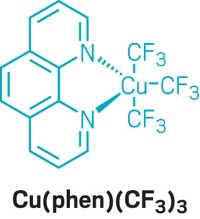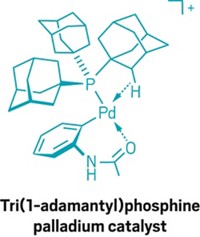Advertisement
Grab your lab coat. Let's get started
Welcome!
Welcome!
Create an account below to get 6 C&EN articles per month, receive newsletters and more - all free.
It seems this is your first time logging in online. Please enter the following information to continue.
As an ACS member you automatically get access to this site. All we need is few more details to create your reading experience.
Not you? Sign in with a different account.
Not you? Sign in with a different account.
ERROR 1
ERROR 1
ERROR 2
ERROR 2
ERROR 2
ERROR 2
ERROR 2
Password and Confirm password must match.
If you have an ACS member number, please enter it here so we can link this account to your membership. (optional)
ERROR 2
ACS values your privacy. By submitting your information, you are gaining access to C&EN and subscribing to our weekly newsletter. We use the information you provide to make your reading experience better, and we will never sell your data to third party members.
Synthesis
Two’s A Charm For Nickel Complex
Organometallics: Low-coordinate nickel species presents intriguing electronic structure and reactivity
by Stephen K. Ritter
January 10, 2011
| A version of this story appeared in
Volume 89, Issue 2
A multi-institution research team has prepared the first two-coordinate transition-metal complex containing an imido ligand. This coordinatively unsaturated nickel(II) complex demonstrates enhanced chemical reactivity over more highly coordinated complexes and potentially signals a new facet of research for organometallic chemists.
The active versions of transition-metal complexes in many chemical reactions, such as olefin metathesis and the reduction of nitrogen to ammonia, contain multiple bonds between a metal with a vacant d orbital and a ligand with abundant electron density. But chemists struggle to re-create these reactive intermediates as isolable molecules.
In a new study, Carl A. Laskowski and Gregory L. Hillhouse of the University of Chicago and coworkers show one way to do it: They pair nickel with an extremely bulky imidazole N-heterocyclic carbene ligand on one side and a bulky terphenyl imido ligand on the other (J. Am. Chem. Soc., DOI: 10.1021/ja1101213).
The “massive steric profile” of the imidazole helps prevent more than two ligands from accessing the nickel, Hillhouse notes. As a result, the complex adjusts its electronic structure by forming a linear C–Ni=N core dominated by π-bonding. The nickel atom features a “high spin” d8 electron configuration with two unpaired electrons, whereas most two-coordinate transition-metal complexes have a paired d10 electron configuration. Study coauthor Thomas R. Cundari of the University of North Texas confirmed these experimental findings with density functional theory calculations.
Reactive substrates such as carbon monoxide and ethylene readily add across the Ni=N bond, resulting in the transfer of the imido group to the substrate to form isocyanates and vinylamines, respectively. This reactivity is greatly enhanced relative to three-coordinate nickel imido complexes, Hillhouse says.
“This piece of work illustrates a new way to effect the catalytic synthesis of organonitrogen compounds,” says Christopher C. Cummins of Massachusetts Institute of Technology, whose group focuses on using large ligands to make low-coordinate complexes. “The two-coordinate nickel imido catalyst itself represents a breakthrough in the chemistry of nickel,” Cummins adds, “and the simplicity of the transfer reaction system renders it amenable to a high degree of mechanistic analysis.”






Join the conversation
Contact the reporter
Submit a Letter to the Editor for publication
Engage with us on Twitter